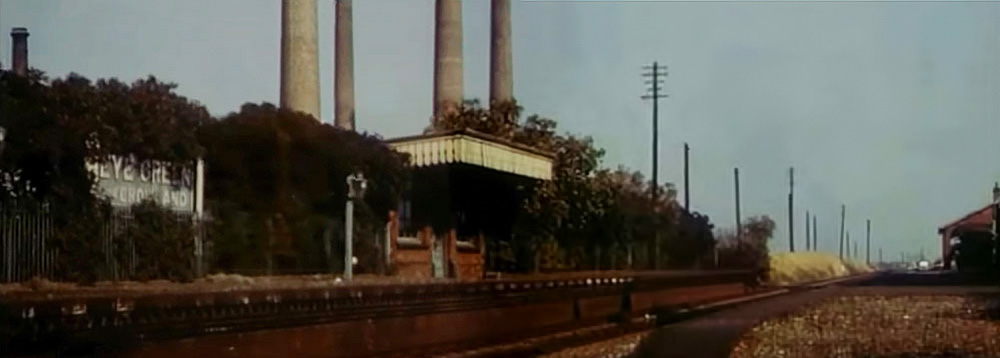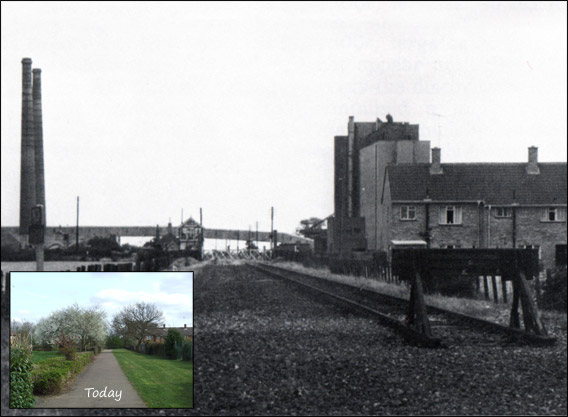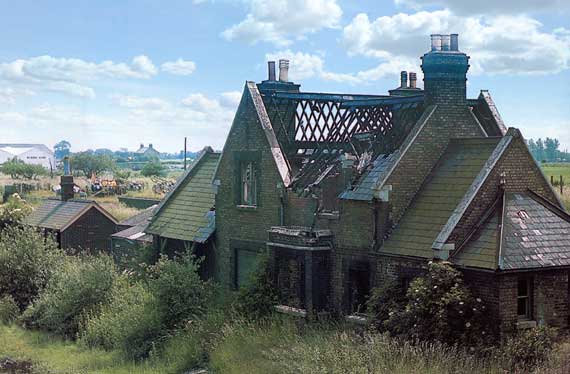
End of the line
Increased car and bus usage, and road haulage, were taking their toll and from the start of 1959 the local papers were reporting on the closure of the line. Cutbacks had started as long ago as September 1936 by the London and North Eastern Railway, which had taken over control of the M&GN. The 50s and 60s were a period of great change on the railways as steam was replaced by diesel. The last ever steam locomotive was built for British Rail in 1960.
In January 1959 the newspapers were reporting on job losses at New England.
| Railwaymen Face an Uneasy New Year
An anxious period of uncertainty lies ahead for Peterborough railway workers, especially for footplate men. There is a steady transfer from steam to diesel working and the prospect of the closure of many branch lines which do not prove a worth-while proposition in the national scheme to streamline Britain’s railways. And later… 10 will lose jobs at New England The imminent closure of the M&GN line, as at present envisaged and will directly cause five drivers and five firemen at New England to become redundant.” A British Railways spokesman at Kings Cross told a reporter. Reference to the closure of the line on the February 28th was made by the N.U.R. district organiser, Mr J. Hall, when he spoke at Peterborough on January 1st, he said, “It means that over 800 men are going to be made redundant. They must uproot themselves, re-settle and start life again, perhaps in some other job than railway work.” |
By the end of January plans for dealing with the loss of services caused by the closure of the line were taking place. Approval was given to Eastern Counties Omnibus Company Ltd to provide passenger services along the routes where the Midland and Great Northern would close.
One of the new services was to run from Peterborough to King’s Lynn in conjunction with existing services. You can still catch the bus or train to Lynn. First Excel XL travels between Peterborough and Norwich via King’s Lynn but you have to travel to Peterborough or Thorney to catch it. In the 1930’s you could catch the 7.08am train from Eye Green and be in South Lynn by 8.07am (59 minutes) . In comparison to today, the 8.40am First Excel from Queensgate will get you to Lynn by 10.12am (1 hour 32 minutes). By train, the 9.18am from Peterborough will arrive in Lynn at 10:31am with a change at Ely (1 hour 10 minutes).
There were also concerns for loss of passenger-related parcel traffic. This was resolved by having a receiving a station at Terrington where fruit and cut flowers could be brought in before being taken by road to King’s Lynn for connecting services.
The last ever passenger train was the 8.37pm from Peterborough to Melton Constable on Saturday 28th February 1959. A reporter from one of the local papers travelled along this last train, it’s not the most endearing report…
| Noisy Farewell To M&GN
The railway that died 30 years ago was finally buried at midnight on Saturday. Hundreds of fog detonators placed on the line at every station on the last trip passenger service from Peterborough on the M&GN ensured that the line really went out with a bang. In the previous few hours, half a dozen trains had completed their last run. The last of all, from Yarmouth, finished its journey at the little station of Stalham 28 minutes before midnight. But the M&GN (muddle and get nowhere) ran true to the end and the last train from Peterborough, the 8.37pm to Melton Constable, was nearly 15 minutes late starting on its run. Peterborough railway enthusiasts showed little interest in the closure, and although a small crowd saw the train off few actually travelled on it. Most of the passengers came to Peterborough on the last ‘up’ train, which left King’s Lynn at 5.45pm and was making a last sentimental journey back to stations between Murrow and Sutton Bridge. Dirt and grime It was nearly 7.15pm when 43090 brought the 5.45pm ex-King’s Lynn into platform two at the North Station and the grimy 4MT had its boiler and tender covered with chalked inscriptions, that had become familiar sights on the line in the few days prior to closure. With ‘old faithful’ chalked in uneven block letters on the boiler – in the place where more impressive locomotives carry nameplates – and M&GN chalked over the B.R. Badge, which almost invisible anyway due to a long accumulation of dirt and grime, 43090 was certainly a contradiction to the spotless locomotives of the line’s heyday. While waiting for their return train the enthusiast from Wisbech, etc, gave the refreshment room one of its liveliest evenings for many a day, but all were lined up like a regiment to go into battle when 43135 brought the seven-coach train into platform three, seconds before the scheduled departure time. With B.R. Badge transformed into something like an out of work character from a Walt Disney Cartoon, down to the nude chalked on the chimney 43135 gave what must have been the line’s most striking display of locomotive decoration ever. “Running out. Please pass.” “We will never pass this way again.” “Bless ‘em all!” the inscriptions left no doubt about the way in which the enthusiasts and railwaymen looked upon the closure. A laurel wreath with a board saying ‘farewell M&GN ” was officially presented and when the guard was sure everyone was on board, the last train slipped out of the station. Driver Watts of Melton gave a noisy farewell on the whistle and as we emerged from Spital Bridge a B1 waiting to go into Spital Loco shed offered her salute. Swinging off the main line at Westwood box, fog detonators announced our arrival on M&GN. metals proper. As ‘Murrow’s last hope’ a gentleman carrying a placard, pushed by me in the corridor, the Norwich people settled down to talk about the match and Wednesday’s replay. By the time we passed over Rhubarb Bridge and ran down the incline to Paston crossing, practically every toilet roll had found a new use and every window had a great length streaming on it. Through the ghost stations at Eye, Thorney and Wryde we only slowed to pick up the single line tokens. But as the train clattered over the flat crossing with the old G.E. March-Spalding line a large reception committee was waiting at Murrow. Murrow is one of the hardest hit places by the closure. Now the trains have gone buses at Guyhirn, three miles away are the only connection with Peterborough and Wisbech. Many passengers left the train and joined up with the people on the platform to sing Auld Lang Syne, and then as everyone scrambled back into their places and as the train moved off again, the people left behind broke in cheers, augmented be car horns and more fog detonators as we crossed the level crossing and headed for Wisbech St Mary. It was the same story here, a short stay, and then more bangs as we left. Rounding the bend into Wisbech North rockets signalled the train’s approach and here too the platforms were crowded. Most of the passengers left the train here, the top-hatted gentlemen, who looked rather like undertakers, included, and as more rockets went up and needless to say a fusillade of bangs, the train, now half empty, pressed on. At Ferry and Tydd the country people said their farewells and after the by now familiar handshakes with the driver and fireman, an, of course, more bangs, the train went on to Sutton Bridge. Here a crowd of over 200 waited on the curving platform and when the train pulled out some enthusiasts raced for their cars to drive along the nearby road into Lynn alongside the train. Through Walpole, Terrington and Clenchwarton, names which meant little to me until Saturday night we travelled, and after crossing the Ouse, detonators every few yards along the track announced our arrival at South Lynn. As the engine was uncoupled to go forward to take water I left the train and transferred to a more humble two-coach push and pull. Soon after 10.15, the train steamed slowly out of the station and the red tail lamp soon disappeared into the night. In contrast to the M&GN, the old London suburban tank with its two former outer London non-corridor coaches was in spotless condition, and this was actually the last departure from South Lynn station. After the M. and G. N. train had gone the solitary bang for the old tank was a bit of an anti-climax, but as we passed South Lynn almost every engine gave its shrill farewell, including a diesel shunter, which after an evening in the almost old-world M&GN gave a reminder of the changing of Britain’s railways that has brought about these economies. |
The 43090 and the 43135 were LMS Ivatt Class 4’s which were built between 1947 and 1952. They were both removed from service in 1965. The only surviving example of the type surviving today is the 43106 which is often seen on the Severn Valley Railway.
The line north of Wisbech was closed first although the Peterborough to Wisbech section remained open until 1960. In 1961 the line from Rhubarb Bridge to Dogsthorpe was removed but trains from the brickyards still ran on the line until the last freight train (carrying bricks) left the Eye Green Station on the 16 April 1966.

The line was actually closed by the Branch Lines Committee of the British Transport Commission (BTC) which was formed in 1949 with a brief to close the least-used branch lines. In total 3,318 miles (5,340 km) of railway were closed between 1948 and 1962, the M&GN being one of them. The infamous Beeching report which came out on the 27 March 1963 closed many more lines across the country, some sensible but others less so.

The ’70s weren’t good to the station and although it was used as a home after closure it eventually became empty and derelict. Sadly it was damaged by fire in suspicious circumstances and threatened with demolition.
The goods shed was taken over by an agricultural chemical specialists and veterinary Supplies company called Key & Pell Ltd.
With plan’s for the northern route of the Eye bypass along the disused line, its future was sealed.
